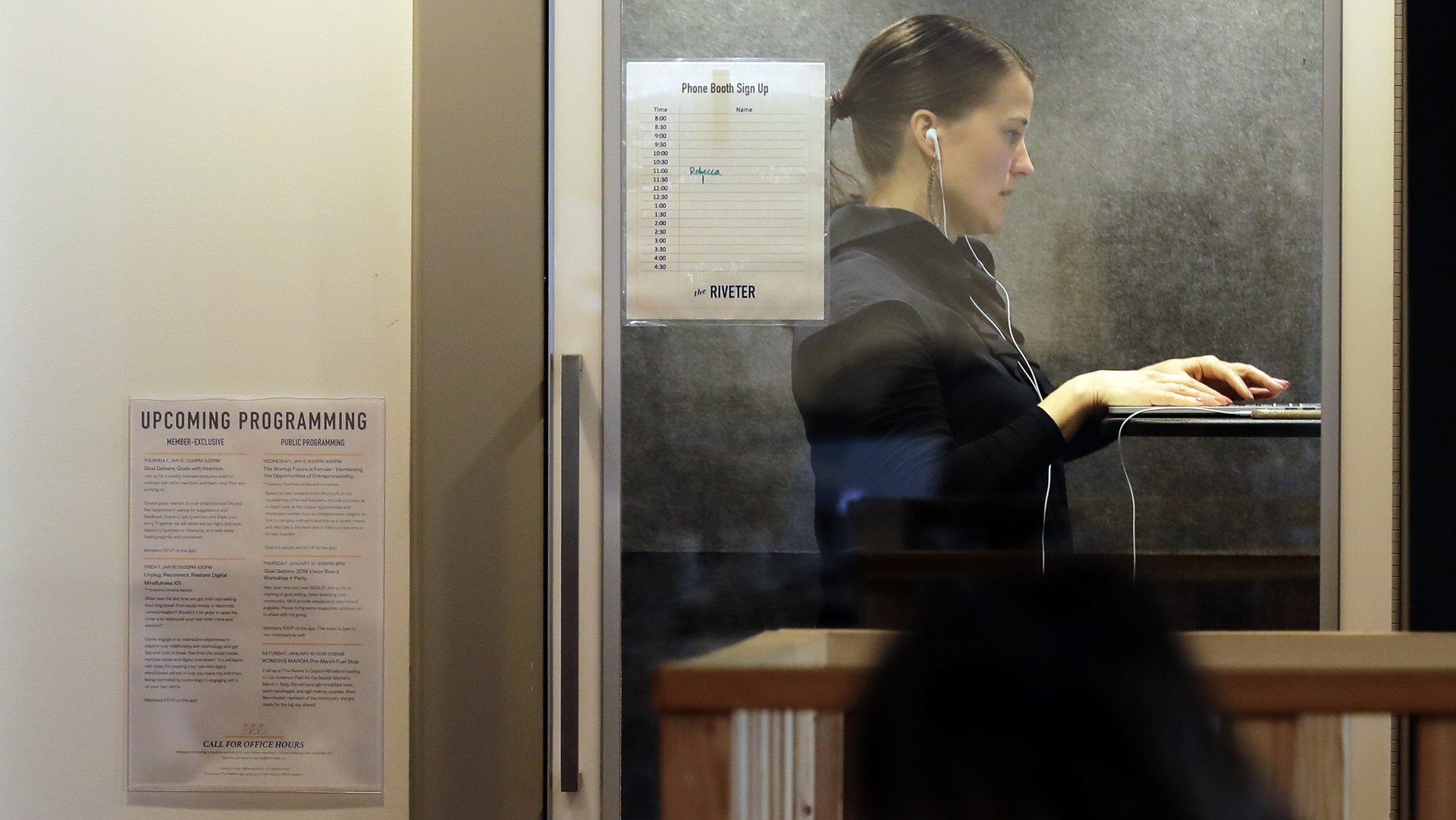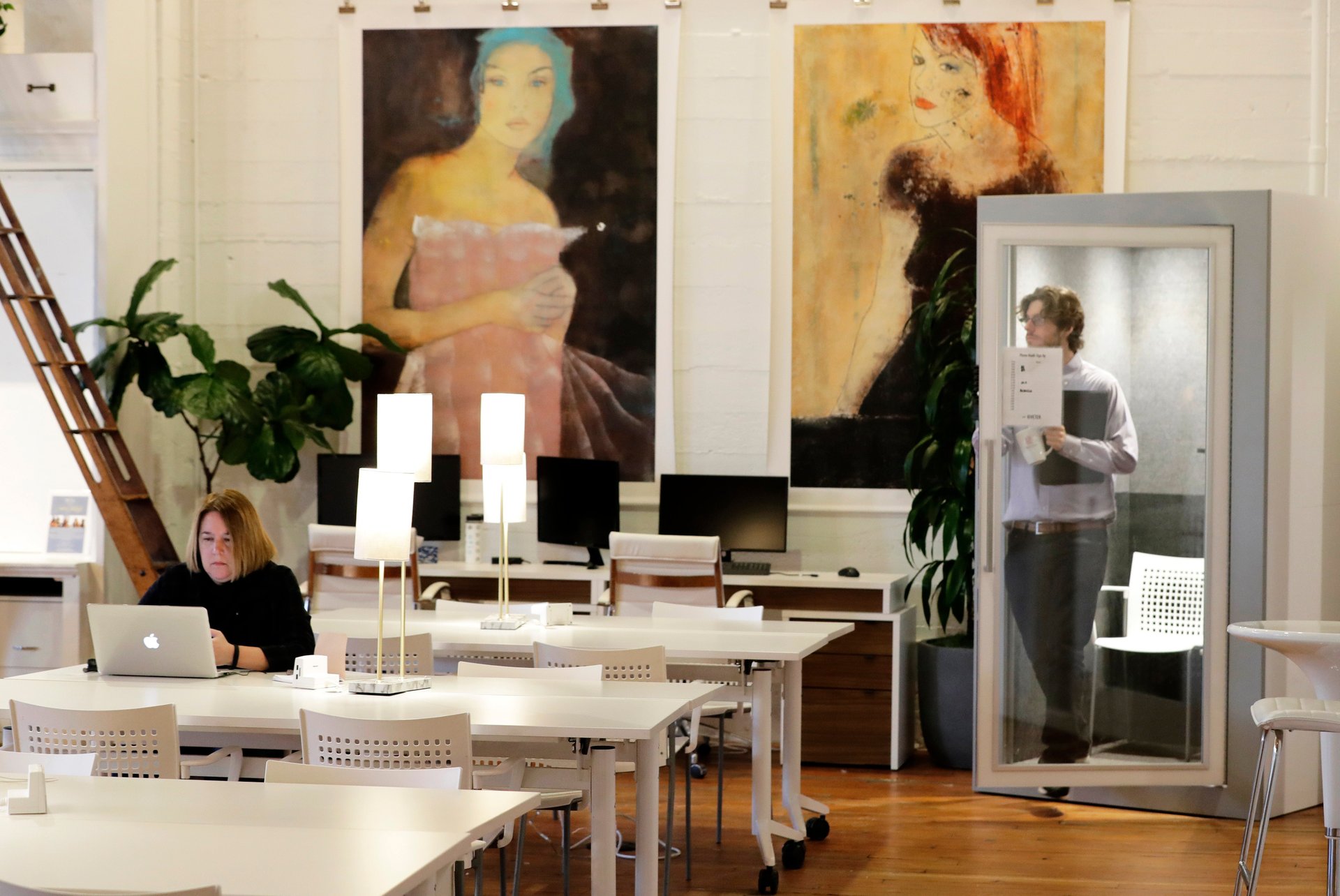Must every office phone booth feel like an upright coffin?
There is nothing fundamentally good about an office phone booth. A sealed-off stall for making private calls is a clunky solution to compensate for the architectural pitfalls of ill-conceived open-plan offices. With not enough attention to built-in acoustical solutions, these offices can be roaringly loud—about 10 decibels higher than what’s ideal for knowledge work, according to a report from Steelcase, the office architecture and furniture giant.


There is nothing fundamentally good about an office phone booth. A sealed-off stall for making private calls is a clunky solution to compensate for the architectural pitfalls of ill-conceived open-plan offices. With not enough attention to built-in acoustical solutions, these offices can be roaringly loud—about 10 decibels higher than what’s ideal for knowledge work, according to a report from Steelcase, the office architecture and furniture giant.
Quartz recently installed two phone booths in our New York office, and I’m sorry to say that the experience of using them is like being trapped in an upright coffin.
The morbid suggestion of expiring inside a padded box in the office is underscored by recent news about WeWork’s toxic phone booths. Last month, the beleaguered co-working company reportedly recalled 2,300 units due to elevated levels of formaldehyde, a substance linked to respiratory issues and, at high levels of exposure, to cancers.
But like it or not, in-office phone booths are here to stay. Rapt Studio founder David Galullo, who has designed offices for companies including PayPal, Vans, GE, and LinkedIn, observes that off-the-shelf options have become imperative. “[It’s] the cost of acknowledging that millions of square feet of open office space was an experiment gone not-exactly-right,” he says.

Clive Wilkinson, the designer of Google’s sprawling Silicon Valley headquarters and author of the new book The Theater of Work, thinks that phone booths are actually great. They fulfill the need for quiet work of video conferencing, without great expense, he explains. “Their small footprint makes them easy to accommodate and also to provide in numbers that make them genuinely useful,” he tells Quartz.
There’s a variety of models, ranging from no-frills cubicles to larger units with motion-activated lights and fans. Beyond considering cost and colors, here are a few pointers for choosing the least oppressive phone booth for your office.
The smell test
WeWork’s faulty booths were discovered when UBS employees complained of a strange odor wafting into their office in Weehawken, New Jersey. The financial services company’s 100,000-sq-ft facility was designed by “Powered By We,” WeWork’s office-property management arm. Fragrance expert Olivia Jezler says that weird smells often tip us to unhealthy materials. “Most felt-type materials chosen for their soundproofing abilities are made with glues that exude toxic fumes,” she explains. Similar adhesives are used in engineered wood products such as the medium-density fiberboard used to build the frames of the booths.
Known widely as an embalming agent, formaldehyde is actually among the most common industrial materials in furniture-making. The US National Institutes of Health say that trace amounts in the air—0.75 parts of formaldehyde per 1 million parts of air—is likely not harmful. The problem, Jezler points out, is that you reach these occupational limits pretty quickly in a sealed-off phone booth because it’s so compact. Whatever the configuration might be, look for models with an air vent, she says.
Wilkinson, too, says airflow is the primary criteria for evaluating phone booths. “If they’re intended to be moveable and indeed considered furniture, they must have either a compact air condition unit or fan that can ensure the internal space is comfortable,” he argues.
The size factor
Before you begin shopping, Galullo says it’s imperative to observe the unique traffic patterns and rhythms in your workplace. If you work in an office that requires a lot of meetings, perhaps choosing a bigger booth that can accommodate a small group is ideal. “In some cases, we are actually designing the noisy spaces to be enclosed,” he explains. “This allows for the more open spaces [to be] governed by rituals of quiet, much like a library reading room.”
Wilkinson says a phone booth that can accommodate two people is the most versatile choice. “I think the best ones have built-in comfortable seating and a very small desk surface for maximum two laptops. The booth should ideally be like an attractive sheltering grotto,” he says.
Jezler, however, cautions against making phone booths too comfortable. “The longer you stay in your ‘focus’ booths, the more likely you will be breathing in formaldehyde at toxic levels,” she says.
Beyond the booth
Beyond phone booths, there are other design interventions to improve the acoustics of open-space layouts. Wilkinson, for instance, pads ceilings to mitigate noise. “It’s important to take out sound that travels vertically, so the space is acoustically manageable. I remember we covered the entire open ceiling at the original Googleplex in 2004 with inexpensive roof insulation material so the space could be quiet,” he says.
Open-plan workplaces can feel so chaotic because they lack “permission signaling” mechanisms like doors in a traditional office. Galullo says you can work around this by clearly designating areas for various activities. “Our solutions have increasingly been leaning toward offering a number of spaces that allow for levels of focus and, conversely, spaces that are free for collaboration and more lively energetic interactions.”
And remember, privacy protection doesn’t have to come in the form of a box. Manufacturers like Vitra, Hayworth, Steelcase, and Ki, for instance, manufacture high-back chairs and pods that offer the acoustical barrier of a phone booth, minus the feeling of being trapped in.